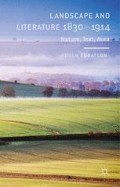Abstract
The semi-mythical territory of the English South Country emerges in the mid-Victorian period as a dialectical response to the espousal of a teleological and historicist investment in the doctrine of human progress. The South Country functions as a ‘dilatory space’ existing in contradistinction to a newly urbanised sense of identity and onward movement. Edward Thomas, whose work takes the form of an elegy for the South Country, defined it as a place which ‘is all “carved out of the carver’s brain”, and has not a name’:
This is not the South Country which measures about two hundred miles from east to west and fifty from north to south. In some ways it is incomparably larger than any country that was ever mapped, since upon nothing less than the infinite can the spirit disport itself.2
The open countryside. — We enjoy being in the open countryside so much because it has no opinion concerning us.
Nietzsche1
Access this chapter
Tax calculation will be finalised at checkout
Purchases are for personal use only
Preview
Unable to display preview. Download preview PDF.
Notes
Friedrich Nietzsche, Human, All Too Human, tr. R. J. Hollingdale (Cambridge: Cambridge University Press, 1986), 181.
Edward Thomas, The South Country (London: Dent, 1993), 8.
Henri Lefebvre, The Production of Space, tr. D. Nicholson-Smith (Oxford: Blackwell, 1991), 21.
Roberto Dainatto, Place in Literature (Ithaca: Cornell University Press, 2009), 9.
George Borrow, Lavengro: The Scholar, the Gypsy, the Priest (London: Dodo Press, 2009), 199. Subsequently cited as L.
George Borrow, The Romany Rye (London: Cresset Press, 1958), 112. Subsequently cited as RR.
Regenia Gagnier, Individualism, Decadence and Globalisation (Basingstoke: Palgrave, 2010), 131.
T. W. Adorno, Minima Moralia, tr. E. Jephcott (London: Verso, 2005), 170, 185.
Katie Trumpener, The Time of the Gypsies’, Critical Inquiry 18 (1992), 857, 870, 853.
Edward Thomas, George Borrow (Teddington: The Echo Library, 2006), 130.
Ian Duncan, ‘Wild England: George Borrow’s Nomadology’, Victorian Studies 41 (1998), 384.
Richard Jefferies, The Story of My Heart (Dartington: Green Books, 2002), 18–19. Subsequently cited as SH.
Maurice Merleau-Ponty, The Phenomenology of Perception (London: Routledge & Kegan Paul, 1962), vii.
Richard Jefferies, ‘On the Downs’, in The Hills and the Vale, ed. E. Thomas (Oxford: Oxford University Press, 1980), 270. Subsequently cited as HV.
Edward Thomas, In Pursuit of Spring (Holt: Laurel Books, 2002), 127.
William Wordsworth, ‘Guilt and Sorrow; or Incidents upon Salisbury Plain’, in The Poems, vol. 1, ed. J. O. Hayden (Harmondsworth: Penguin, 1977), 119. Subsequently cited as Poems.
For a full account of the ownership of the monument in the nineteenth century see Barbara Bender, ‘Stonehenge — Contested Landscapes’, in Landscape: Politics and Perspectives, ed. B. Bender (Oxford: Berg, 1993), 245–79.
Thomas Hardy, Tess of the d’Urbervilles, ed. J. Grindle and S. Gatrell (Oxford: Oxford University Press, 1998), 379, 381. On Hardy’s archaeological reading of landscape more generally see Allison Adler Kroll, ‘Hardy’s Wessex, Heritage Culture, and the Archaeology of Rural England’, Nineteenth-Century Contexts 31(2010), 335-52.
Thomas Hardy, The Complete Poems, ed. J. Gibson (London: Macmillan, 1976), 306.
W. H. Hudson, A Shepherd’s Life (London: Methuen, 1951), 5. Subsequently cited as ASL.
Christopher Tilley, The Materiality of Stone (New York: Berg, 2004), 221.
Christopher Tilley, A Phenomenology of Landscape (New York: Berg, 1994), 21.
V. S. Naipaul, The Enigma of Arrival (Harmondsworth: Penguin, 1987), 15.
Author information
Authors and Affiliations
Copyright information
© 2013 Roger Ebbatson
About this chapter
Cite this chapter
Ebbatson, R. (2013). Traversing the South Country, 1850–1914. In: Landscape and Literature 1830–1914. Palgrave Macmillan, London. https://doi.org/10.1057/9781137330444_13
Download citation
DOI: https://doi.org/10.1057/9781137330444_13
Publisher Name: Palgrave Macmillan, London
Print ISBN: 978-1-349-46102-8
Online ISBN: 978-1-137-33044-4
eBook Packages: Palgrave Literature CollectionLiterature, Cultural and Media Studies (R0)

